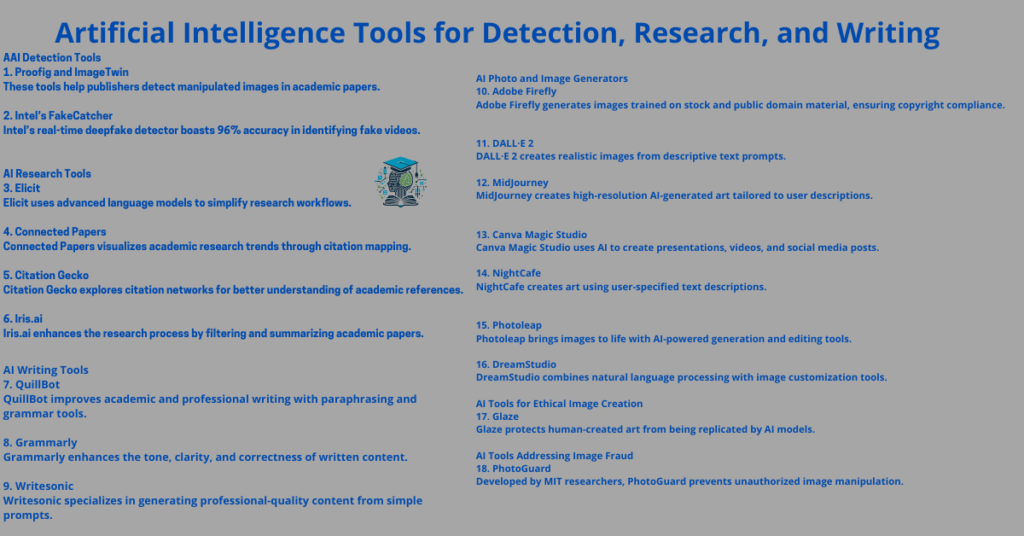
Artificial Intelligence (AI) is reshaping industries by offering tools that streamline workflows, enhance creativity, and solve complex challenges. In academia and content creation, AI tools are indispensable for detecting fake content, conducting in-depth research, and generating professional-grade writing and images. This blog dives deep into the landscape of AI tools, detailing their capabilities, applications, and implications.
AI tools bring speed, precision, and versatility to various tasks, including:
Detection: Identifying AI-generated or manipulated content to uphold authenticity.
Research: Streamlining literature reviews, citation management, and data analysis.
Writing: Assisting with drafting, paraphrasing, and grammar improvement.
Image Creation: Producing AI-generated visuals and enhancing multimedia content.
Whether you’re an academic, creative professional, or businessperson, leveraging these tools can save time and improve the quality of your work.
Proofig and ImageTwin
These tools help publishers detect manipulated images in academic papers.
Features:
Identifies inconsistencies in image data.
Supports the integrity of scientific research.
Intel’s FakeCatcher
Intel’s real-time deepfake detector boasts 96% accuracy in identifying fake videos.
Features:
Instantaneous results.
Useful for media verification and fraud prevention.
Elicit
Elicit uses advanced language models to simplify research workflows.
Features:
Automates literature reviews.
Summarizes findings based on user queries.
Connected Papers
Connected Papers visualizes academic research trends through citation mapping.
Features:
Builds networks of related papers.
Highlights prior and derivative works.
Citation Gecko
Citation Gecko explores citation networks for better understanding of academic references.
Features:
Clusters papers by relevance.
Facilitates thematic exploration.
Iris.ai
Iris.ai enhances the research process by filtering and summarizing academic papers.
Features:
Smart filters for contextual results.
Data extraction and systematization.
QuillBot
QuillBot improves academic and professional writing with paraphrasing and grammar tools.
Features:
Paraphrases text for clarity.
Suggests grammar and style improvements.
Grammarly
Grammarly enhances the tone, clarity, and correctness of written content.
Features:
Advanced grammar checking.
Tone adjustments for professional and casual writing.
Writesonic
Writesonic specializes in generating professional-quality content from simple prompts.
Features:
Supports SEO writing.
Simplifies complex ideas for broader audiences.
Adobe Firefly
Adobe Firefly generates images trained on stock and public domain material, ensuring copyright compliance.
Features:
High-quality visual creation.
Customizable styles and effects.
DALL·E 2
DALL·E 2 creates realistic images from descriptive text prompts.
Features:
Multimodal capabilities for combining text, images, and video.
User-friendly input customization.
MidJourney
MidJourney creates high-resolution AI-generated art tailored to user descriptions.
Features:
Ideal for conceptual and creative visuals.
Produces professional-quality graphics.
13. Glaze
Glaze protects human-created art from being replicated by AI models.
Features:
Alters images subtly to prevent AI style mimicry.
PhotoGuard
Developed by MIT researchers, PhotoGuard prevents unauthorized image manipulation.
Features:
Secures image authenticity.
Guards against deepfake applications.
Addressing Bias in AI Models
AI tools like Google Gemini have faced criticism for perpetuating cultural and racial biases in their outputs. Ensuring ethical training and usage of AI tools is critical to mitigating these challenges.
Combating Disinformation
Generative AI’s ability to create highly realistic fake images and videos has raised concerns about its misuse in media and politics. Tools like Intel’s FakeCatcher play a vital role in combating disinformation.
AI is transforming workflows by:
When selecting an AI tool, consider:
Functionality: Does the tool meet your specific needs?
Ease of Use: Look for intuitive interfaces and minimal learning curves.
Cost: Compare free and premium options to fit your budget.
What is the best AI tool for academic research?
Tools like Elicit and Connected Papers are excellent for literature reviews and data exploration.
Can AI tools help with citation management?
Yes, tools like Citation Gecko and Iris.ai excel at organizing and visualizing citations.
Are AI-generated images copyright-free?
Some tools, like Adobe Firefly, ensure compliance with copyright laws by using public domain materials.
What is the best tool for detecting fake images?
Intel’s FakeCatcher and PhotoGuard are among the best tools for detecting and preventing image fraud.
Are AI tools for writing reliable?
Yes, tools like Grammarly and Writesonic improve clarity, tone, and correctness in writing.
AI tools are revolutionizing how we approach detection, research, and writing. From enhancing productivity to ensuring ethical content creation, these tools empower users to excel in their academic, professional, and creative endeavors.
By leveraging the right tools and staying mindful of their ethical implications, we can navigate the evolving AI landscape responsibly and effectively.

Dr. Chopra is the founder and editor of thephdcoaches.blogs and Thephdcoaches Learn more about her here and connect with her on Instagram, Facebook and LinkedIn.
Dr. Tripti Chopra, founder of The PhD Coach, is an award-winning mentor and leader in integrating AI into academic research, with over a decade of experience guiding PhD students and researchers. Her work revolutionizes research processes, promotes sustainable writing practices, and inspires scholars to embrace technological advancements.
Copyright© 2023 Thephdcoach All rights reserved.
Leave a Comment